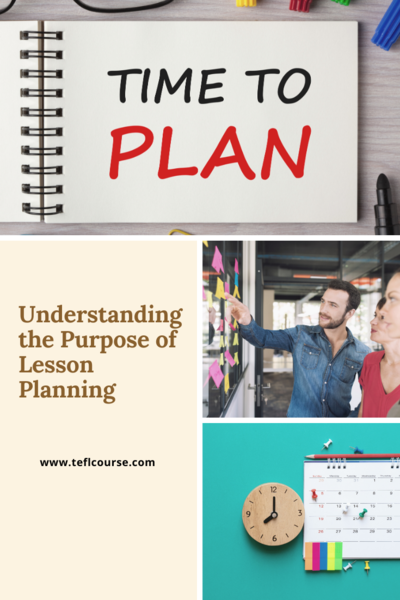Understanding the Purpose of Lesson Planning

When entering the realm of teaching, lesson planning is a very beneficial skill to have. Lesson planning is done in many different ways; many educators create their format over the years that cater to their teaching styles. However, the typical lesson planning methodologies include ESA (Engage, Study, Activate) and PPP (Presentation, Practice, Production). For this task, we will be diving into the ESA methodology.
Table of Contents
Lead them through the study process
Help students to "switch on" their skills
Do you want to teach English abroad? Take a TEFL course!
This post was written by our TEFL certification graduate Gabrielle R. Please note that this blog post might not necessarily represent the beliefs or opinions of ITTT.
Engage your students
The first stage of the ESA format is 'Engage'. In this stage of the lesson, the focus should be on getting your students as interested and engaged as possible. This ensures the students can absorb the information given throughout the lesson and are likelier to continue coming to the class. To engage our students, we should try to vary the different activities and 'warmers' used at the beginning of the class so that they do not become tired of doing the same thing every day. Pictures, music, and stories are all great tools that engage learners. It is important to note that at this stage of the lesson, no new information or vocabulary should be introduced to the students.
Also Read: Where can I teach English abroad without a university degree?
Lead them through the study process
The second stage of ESA lesson planning is where we would elicit previously learned vocabulary and grammatical ideas from the students. The 'Study' phase of ESA begins with elicitation using writing on the board, asking knowledge prompting questions and drilling exercises to check pronunciation. Once the language topic has been addressed, we move onto activities that check the students' comprehension and reinforce the lesson material such as 'fill-in-the-gap' worksheets. After these are completed, it is good to review all of the answers as a class to ensure everyone has the same answers and, if necessary, practice the correct pronunciation again. It is good to allow the students to work individually or in groups to study and practice the language alone and together.

Also Read: How do I apply for a student visa to legally teach English in Spain?
Help students to "switch on" their skills
The final phase of ESA lesson planning is 'Activate'. At this point in the lessons, the students should have a fairly good understanding of the language concept and possibly learned some new vocabulary along the way. The learners should be encouraged to use any of the English languages that they know. The conversation should be as fluid and communicative as possible, whether it be during a class activity or during a group project. The focus here is to allow the students to speak with fluency and no restrictions on language usage (assuming it pertains to the lesson). The typical activities used during this phase include communication games, debates (depending on the class level), story writing, and roleplaying.
Also Read: Can I cancel my contract early when teaching English abroad?
Other Techniques
All three of these phases are equally important but they are not necessarily used in the same order at all times. We can vary the different phases to create more fluidity and flexibility in the lesson content. The three main lesson sequences used in ESA methodology are the 'Straight Arrow', the 'Boomerang', and the Patchwork'.
In the 'Straight Arrow' sequence, the teacher takes the format in order. First Engage, then Study and lastly Activate. In the 'Boomerang' sequence, the teacher is given more possibilities for activities in the classroom, while still incorporating the ESA format. The 'Boomerang' typically goes Engage, then Activate 1, Study, then Activate 2. The final sequence, 'Patchwork', is the most flexible of them all. In this sequence, it does not matter how many of each phase is used or in which order they are used, just as long as it begins with Engage and finishes with Activate.
Although not all educators find lesson planning to be a necessary part of teaching, many can agree it is better to have a plan than to be left unprepared. Imagine walking into your class with a general idea of what language concept or vocabulary you will teach and how you will teach it, however, when you begin to teach, you realize that it may have been easier for the students to grasp if you had reintroduced a piece of older information first. If you had outlined and planned out your lesson first, likely, this would not have happened.
Also Read: How can I avoid scams when looking for TEFL jobs?
Do you want to teach English abroad? Take a TEFL course!
We must understand that, as the course progresses, we will see patterns in the student's work and development that will assist us in making sure our students fully comprehend the concepts being taught; but also how to correct and encourage the students in the areas they do need extra assistance in. We are then able to determine which activities are helpful and which are confusing and do not match the learning styles of the students. Summatively speaking, lesson planning is an integral part of our roles as educators, whether it be a simple outline or a detailed formatted document.
Apply now & get certified to teach english abroad!
Speak with an ITTT advisor today to put together your personal plan for teaching English abroad.
Send us an email or call us toll-free at 1-800-490-0531 to speak with an ITTT advisor today.
Related Articles:
- The How-To Guide to Prepare for Your Teaching Job Abroad
- The Top 5 TEFL Destinations for Adrenaline Junkies and Adventure Seekers
- 9 Small Details That Matter When Teaching EFL
- The Advantages and Disadvantages of Teaching English to Young Children
- 7 Teaching Skills in the Classroom You need To Incorporate into Your Lessons
- What TEFL course is most useful?




